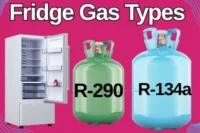How an Air Conditioner Works in Simple Words
Published: 13 Oct 2025
It’s a hot summer afternoon, and you’ve just come home, sweating and tired. You press the AC button, and within minutes, cool air fills the room. The heat fades away, and you finally feel calm again. But have you ever stopped to think about what’s really happening inside that box on your wall? That’s the magic behind how an air conditioner works. It quietly pulls heat from your room and replaces it with refreshing cool air, providing instant comfort when you need it most.
Curious to know how ACs work and keep your room cool on hot days? Let’s learn step by step and make it easy to understand!
Are you ready? Let’s start.
What an Air Conditioner Actually Does
An air conditioner simply removes heat and humidity from the air inside your room. It takes away the warm air, cools it down, and sends it back fresh and comfortable.
Think of it like a sponge soaking up heat. It absorbs the hot air, squeezes out the heat, and then blows cool air back to you. Just like how ice water cools your hands on a hot day, the AC cools the air around you.
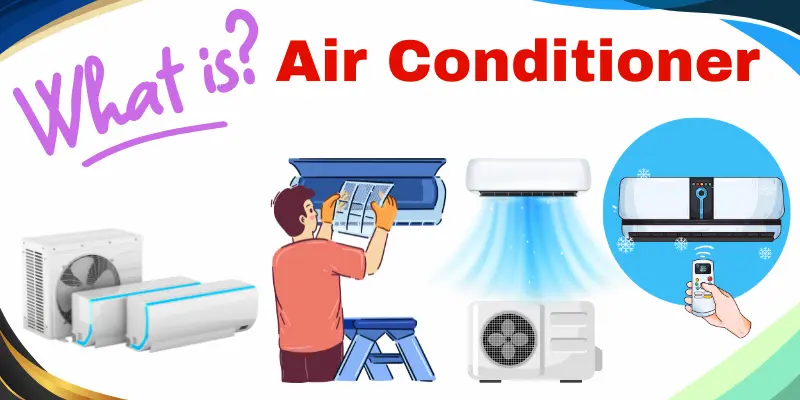
Modern air conditioners do even more than cool. They clean the air, remove dust and allergens, and keep air moving so your room always feels fresh and healthy.
👉 Now, let’s see how this cooling process actually happens inside your air conditioner!
Main Parts of an Air Conditioner
An air conditioner has many small parts that work together to keep you cool.
If we look closely, the whole system has three main parts. These parts help the AC move heat and make the air fresh.
- Indoor Unit
- Outdoor Unit
- Connection System
Now we will discuss each part one by one. First, we will start with the indoor unit.
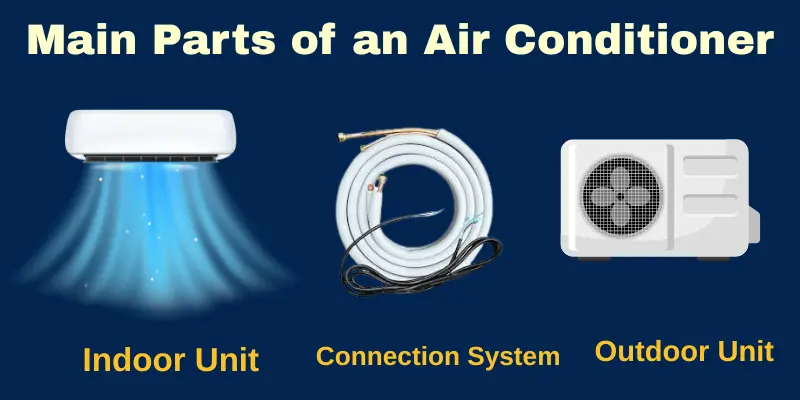
Are you ready? Let’s discuss each part in detail together.
Indoor Unit
The indoor unit is the part of your air conditioner that stays inside your room.
It cools the air, removes humidity, and spreads the cool air evenly throughout your space.
Here are the main parts of the indoor unit:
- Front Cover / Body Panel
- Air Filters
- Evaporator Coil
- Expansion Valve
- Indoor Blower Motor (Fan Motor)
- Drain Tray / Water Tray
- Coil Sensor
- Room Temperature Sensor
- Up-Down Swing Motor (Vertical Flap Motor)
- Left-Right Swing Motor (Horizontal Flap Motor)
- LCD Display Panel
- Indoor Unit PCB (Printed Circuit Board)
- Wi-Fi Device / Module
- Remote Control / Smart Control System
These parts work together to cool, clean, and circulate air to keep your room fresh and comfortable.
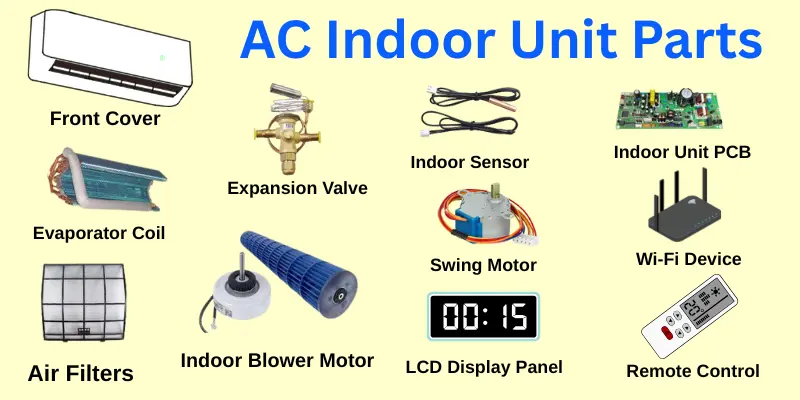
Let’s discuss all the parts in the list in detail, one by one. Are you ready? Let’s see.
1. Front Cover / Body Panel
The front cover, also called the body panel, is the outer shell of the indoor unit. It protects all the parts inside, keeps the AC clean and neat, and gives it a modern look. It also helps hold the display panel, flap motors, and other components in place.
- Protects internal parts from dust, dirt, and accidental damage.
- Holds the LCD display and swing motors securely.
- Gives the AC a finished, attractive appearance.
- It can be easily opened for maintenance or cleaning.
- Prevents small objects from entering the unit.
2. Air Filters
Air filters are placed just behind the front cover. They clean the air before it passes through the AC, keeping your room fresh and healthy.
- Trap dust, dirt, pollen, and small particles.
- Ensure the air you breathe is clean.
- Help the AC work efficiently by preventing clogs.
- Reduce wear and tear on the evaporator coil and blower motor.
- It can be removed and washed easily for regular maintenance.
3. Evaporator Coil
The evaporator coil is the main part that cools the air inside your room. It absorbs heat from the warm air and removes humidity to make the room comfortable.
- Contains a refrigerant that absorbs heat from the air.
- Reduces the air temperature before it is blown out.
- Removes moisture from the air to reduce humidity.
- Needs regular cleaning for better efficiency.
- Works continuously with the blower motor to keep the air cool.
4. Expansion Valve
The expansion valve controls how much refrigerant enters the evaporator coil. It ensures the refrigerant is at the right pressure for cooling.
- Reduces the pressure of the refrigerant to make it cold.
- Helps maintain the correct cooling level.
- Ensures smooth operation of the AC.
- Prevents overcooling or undercooling of the air.
- Works automatically with the AC system.
5. Indoor Blower Motor (Fan Motor)
The blower motor pushes cool air from the evaporator coil into the room. It helps circulate air evenly for better comfort.
- Moves cool air throughout the room.
- Works quietly in modern ACs.
- Helps maintain an even temperature in all corners.
- Works with swing motors to spread air effectively.
- Ensures the AC operates efficiently.
6. Drain Tray / Water Tray
The drain tray collects water that forms when air is cooled and moisture condenses. It prevents water from dripping inside the room.
- Collects condensed water from the coil.
- Sends water outside through a drain pipe.
- Prevents water damage inside the unit.
- Reduces the chances of mold growth.
- Ensures smooth and hygienic AC operation.
7. Coil Sensor
The coil sensor monitors the temperature of the evaporator coil to prevent freezing.
- Detects coil temperature in real-time.
- Sends signals to the PCB to control cooling.
- Prevents the coil from freezing or overcooling.
- Helps maintain energy-efficient operation.
- Works with the room sensor to keep the AC stable.
8. Room Temperature Sensor
The room temperature sensor measures the temperature of the air inside the room.
- Sends data to the PCB to adjust cooling automatically.
- Helps maintain the temperature set on the remote.
- Improves the energy efficiency of the AC.
- Prevents unnecessary overcooling.
- Ensures comfort in the entire room.
9. Up-Down Swing Motor (Vertical Flap Motor)
This motor moves the vertical flaps of the AC to direct air upward or downward.
- Spreads cool air in multiple directions.
- It can be controlled via the remote.
- Prevents cold spots in the room.
- Works continuously to distribute air evenly.
- Improves overall cooling comfort.
10. Left-Right Swing Motor (Horizontal Flap Motor)
This motor moves the horizontal flaps from side to side to distribute air evenly.
- Directs airflow to all corners of the room.
- Works with the vertical flap motor for full coverage.
- Helps maintain uniform temperature.
- Prevents air from blowing directly in one spot.
- Enhances the comfort level in the room.
11. LCD Display Panel
The LCD display panel shows the AC’s current settings, mode, and temperature.
- Displays AC operation mode, fan speed, and temperature.
- Shows timer settings and error codes if there is a problem.
- Helps users operate the AC easily.
- Makes it simple to monitor the AC’s status.
- Provides clear visual information at a glance.
12. Indoor Unit PCB (Printed Circuit Board)
The PCB is the brain of the indoor unit. It controls the functioning of the AC based on sensor signals.
- Receives signals from the remote and sensors.
- Controls the blower motor, swing motors, and other components.
- Ensures smooth and safe operation.
- Prevents malfunction by managing system responses.
- Maintains stability and energy efficiency.
13. Wi-Fi Device / Module
The Wi-Fi module connects your AC to smart devices for remote control.
- Allows control via smartphone or smart home apps.
- Enables turning the AC on or off remotely.
- Let’s you set timers or adjust temperature from anywhere.
- Makes the AC convenient and smarter to use.
- Works with voice assistants in modern setups.
14. Remote Control / Smart Control System
The remote control is the main tool to operate the AC from a distance.
- Sets temperature, fan speed, mode, and swing directions.
- Let’s you turn the AC on or off without touching the unit.
- Works with apps or voice assistants in smart ACs.
- Provides easy control for everyone in the room.
- Ensures a comfortable and convenient AC experience.
Now that we have discussed all the important parts of the indoor unit and how they work together to keep your room cool, it’s time to move outside. In the next section, we will explore the outdoor unit and see how it releases heat and helps the AC function properly.
Outdoor Unit
The outdoor unit is the part of the air conditioner that stays outside your home. It works together with the indoor unit to remove heat from your room and release it into the outside air. This unit contains several important components that make cooling possible, keep the system efficient, and protect the AC from damage.
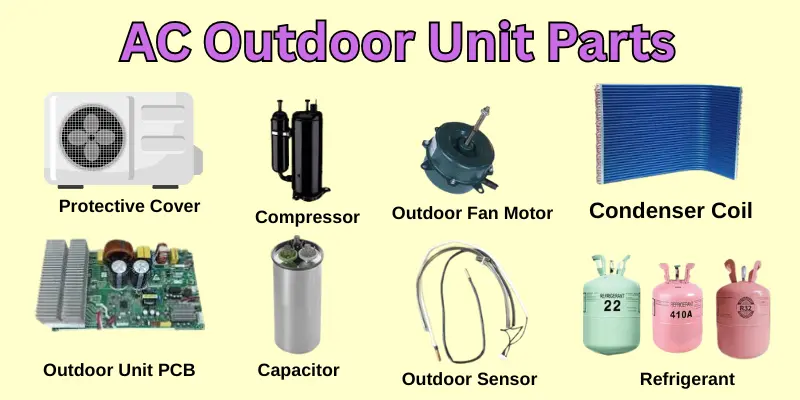
Here are the main parts of the outdoor unit:
- Protective Cover / Body Panel
- Outdoor Unit PCB (Printed Circuit Board)
- Compressor
- Capacitor
- Compressor Sensor
- Condenser Coil
- Condenser Sensor
- Outdoor Fan Motor
- Outdoor Temperature Sensor
- Refrigerant
Let’s discuss all the parts in the list in detail, one by one. Are you ready?
1. Protective Cover / Body Panel
The protective cover is the outer shell of the outdoor unit that keeps all the inside parts safe from rain, dust, and sunlight. It is built to handle outdoor weather and protect the system from damage while giving it a clean, strong look.
- Made of durable metal or plastic that resists heat and rust.
- Shields the compressor, condenser coil, and wires from weather damage.
- Helps reduce noise when the AC is running.
- Stops insects, leaves, and small objects from getting inside.
- Keeps the outdoor unit neat, safe, and long-lasting.
2. Outdoor Unit PCB (Printed Circuit Board)
The Outdoor Unit PCB is like the brain of the outdoor system. It controls how the compressor, fan motor, and sensors work together. In inverter air conditioners, this board plays an even bigger role-it controls the compressor’s speed to save electricity and keep cooling steady.
- Sends and receives signals from the indoor PCB for smooth operation.
- Controls the compressor, fan motor, and sensors based on temperature needs.
- Helps maintain energy efficiency, especially in inverter ACs.
- Protects the outdoor unit from overload or power faults.
- Without this board, the AC cannot run or respond properly.
3. Compressor
The compressor is the heart of the outdoor unit; it pumps the refrigerant throughout the system. Its main job is to compress the low-pressure gas from the indoor unit into a high-pressure, high-temperature gas. This process helps move heat from inside your room to the outside air. In inverter ACs, the compressor can adjust its speed to save energy and give stable cooling.
- Circulates the refrigerant between the indoor and outdoor units.
- Converts low-pressure gas into high-pressure gas for heat removal.
- Works continuously to keep your room cool.
- In inverter ACs, the speed changes are used to reduce power and avoid frequent starts.
- Needs proper maintenance to ensure long life and quiet performance.
4. Capacitor
The capacitor is a small but important part used mostly in normal (non-inverter) air conditioners. It is fixed near the compressor and helps it start when you turn on the AC. The capacitor stores a little electric power and gives it to the compressor and fan motor to help them start quickly. Without it, the AC may not start or may stop working properly.
- Used mainly in non-inverter ACs to start the compressor and fan.
- Stores some power and releases it when the AC starts.
- Helps the compressor and fan motor run smoothly.
- If it gets weak or damaged, the AC won’t cool properly.
- It should be checked during regular service to keep it safe and working well.
5. Compressor Sensor
The compressor sensor is a small but important part mostly used in inverter air conditioners. It checks the temperature of the compressor to make sure it doesn’t get too hot while running. Some companies place this sensor on the discharge pipe, while others fix it directly on the compressor body. It helps the system control cooling and protect the compressor from damage.
- Found mainly in inverter ACs for safety and control.
- Monitors the compressor’s temperature during operation.
- Sends signals to the PCB to adjust compressor speed or stop it if it gets too hot.
- Keeps the system safe from overheating or damage.
- Helps the AC run smoothly and last longer.
6. Condenser Coil
The condenser coil is one of the most important parts of the outdoor unit. It helps release the heat that comes from inside your room. When the hot refrigerant gas from the compressor passes through this coil, the coil cools it down and turns it back into a liquid. This way, all the heat collected from your room goes out into the air.
- Made of copper or aluminum tubes for better heat transfer.
- Helps remove heat from the refrigerant gas.
- Turns hot gas into a cool liquid before it goes back inside.
- Needs to stay clean for smooth and fast cooling.
- A dirty or damaged coil can make the AC cool slowly or use more power.
7. Condenser Sensor
The condenser sensor is another small but useful part mostly found in inverter air conditioners. Its job is to check the temperature of the condenser coil while the AC is running. This helps the PCB control how much the compressor should work and prevents the system from getting too hot. Some companies fix this sensor directly on the coil, while others attach it near the outdoor fan area.
- Commonly used in inverter ACs for smart temperature control.
- Monitors the heat level of the condenser coil.
- Sends signals to the PCB to adjust compressor speed or fan operation.
- Helps protect the outdoor unit from overheating.
- Keeps cooling steadily, and energy use is low.
8. Outdoor Fan Motor
The outdoor fan motor helps blow air over the condenser coil to remove heat. It works together with the compressor to push the hot air outside. This motor keeps the outdoor unit cool and helps the AC run smoothly. If it stops working, the AC will not release heat properly, and cooling will become weak.
- Blows air across the condenser coil to release heat.
- Keeps the outdoor unit cool and prevents overheating.
- Works in both inverter and non-inverter ACs.
- Needs regular cleaning to remove dust and dirt.
- A faulty fan motor can reduce cooling and increase power use.
9. Outdoor Temperature Sensor
The outdoor temperature sensor is mostly used in inverter air conditioners. It measures the air temperature outside your home. This information helps the PCB decide how hard the compressor should work. For example, when it’s very hot outside, the compressor runs faster to cool the room quickly.
- Found mainly in inverter ACs for better control and power saving.
- Measures the temperature of the air outside.
- Sends data to the PCB to adjust compressor speed.
- Helps the AC work smartly in different weather conditions.
- Improves cooling comfort and energy efficiency.
10. Refrigerant
The refrigerant is the cooling gas that flows through the whole air conditioner. It carries heat from inside your room to the outside unit. When it passes through the indoor coil, it absorbs heat and turns into a gas. Then, in the outdoor unit, it releases that heat and becomes a liquid again. This cycle keeps repeating to make your room cool.
- Works as the “blood” of the air conditioner system.
- Absorbs heat indoors and releases it outdoors.
- Common types include R32, R410A, and R22 (older models).
- Must stay at the right pressure for perfect cooling.
- Leaks or low gas levels can cause poor cooling and higher bills.
Connection System
The connection system is the link between the indoor and outdoor units of an air conditioner. It allows both units to work together and keep your room cool. This system helps in the flow of refrigerant, power, and signals between the two parts. Without proper connections, your AC cannot run smoothly or give good cooling. It’s like the bridge that connects the inside and outside of your home for perfect temperature control.
Here are the main parts of the connection system:
- Refrigerant Pipes / Copper Pipes
- Drain Pipe / Water Pipe
- Communication Wires / Control Wires
- Power Cable / Supply Wire
- Insulation Material
- Outdoor Bracket / Mounting Stand
- Wall Hole Cover / Sleeve (for neat pipe entry)
- Pipe Tape / Covering Tape
These parts together make sure the AC runs safely, looks tidy, and gives smooth cooling performance.
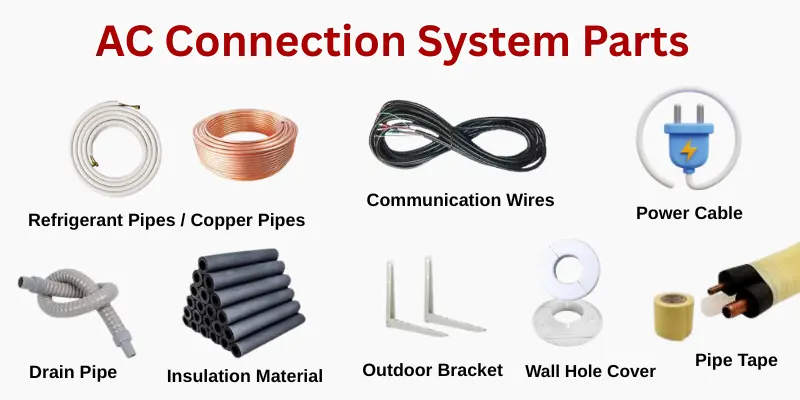
Now we discuss all the points given in the list one by one in detail.
1. Refrigerant Pipes / Copper Pipes
Refrigerant pipes are like the veins of your air conditioner. They carry the cooling gas (refrigerant) between the indoor and outdoor units. These pipes are made of copper, which is strong and allows the gas to flow easily.
- Carry refrigerant back and forth for cooling.
- One pipe is for gas (the larger one) and one for liquid (the smaller one).
- Made of copper to stop leaks and handle pressure.
- Must be sealed tightly to avoid gas loss.
- Covered with insulation to keep the cooling effect strong.
2. Drain Pipe / Water Pipe
The drain pipe removes the water that forms inside the indoor unit when the air cools down. It keeps your room dry and clean.
- Carries the water outside safely.
- Prevents water from dripping inside the room.
- Usually made of flexible plastic.
- It must be installed with a downward slope so water can flow easily.
- Needs regular cleaning to stop blockages or bad smells.
3. Communication Wires / Control Wires
These wires help the indoor and outdoor units talk to each other. They send signals and make sure both parts work together perfectly.
- Carry signals between the two units.
- Help the indoor unit tell the outdoor unit when to start or stop.
- Also, send temperature and sensor data.
- Must be connected correctly to avoid errors.
- Usually come in a group of 3 or 4 colored wires.
4. Power Cable / Supply Wire
The power cable gives electricity to your AC so it can run properly. Without this, your AC cannot start or work.
- Supplies power to both units.
- Must be of the right thickness for safety.
- Connects directly to the power source or switch.
- It should be checked regularly for wear and tear.
- Must be fitted by a trained technician for safety.
5. Insulation Material
Insulation keeps the cooling gas cold while it moves through the pipes. It helps save energy and makes cooling faster.
- Wraps around the copper pipes tightly.
- Prevents the gas from losing coolness.
- Stops pipes from sweating or forming water drops.
- Helps the AC work more efficiently.
- Needs replacement if torn or damaged.
6. Outdoor Bracket / Mounting Stand
The outdoor bracket or stand holds the outdoor unit safely in place. It keeps the unit strong and stable.
- Made of strong metal to handle the unit’s weight.
- Fixed on the wall or ground firmly.
- Helps keep good airflow around the unit.
- Prevents vibration and noise during operation.
- Must be rust-proof for long life.
7. Wall Hole Cover / Sleeve
The wall hole cover is the small ring that seals the hole where pipes pass through the wall. It makes the setup look clean and safe.
- Keeps insects and dust out of the wall hole.
- Protects the pipes from damage.
- Gives a neat look to the installation.
- Made of plastic or rubber.
- Easy to remove if service is needed.
8. Pipe Tape / Covering Tape
Pipe tape is used to wrap all the pipes and wires together neatly. It makes the installation look organized and safe.
- Holds all pipes, wires, and insulation tightly.
- Protects them from sunlight and dust.
- Keeps everything in one clean bundle.
- Usually made of white or black PVC tape.
- Gives a professional finish to the AC setup.
How an Air Conditioner Works (Step by Step)
When you switch on your air conditioner, it quietly starts a smart cooling process to make your room comfortable. The AC doesn’t just blow cold air – it actually removes heat from your room and throws it outside. Let’s look at how this cooling process happens step by step.
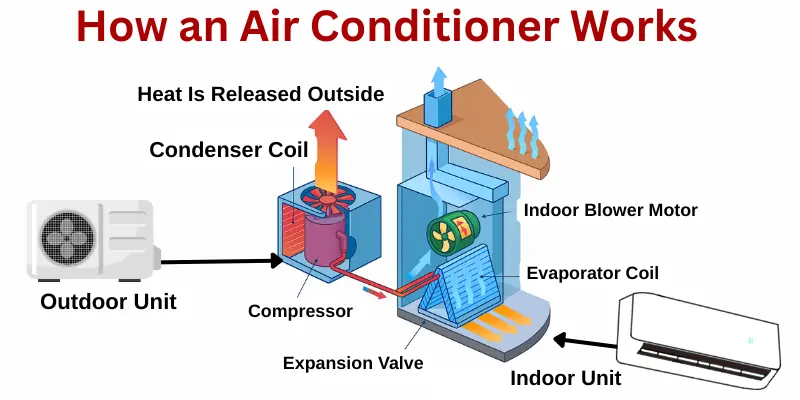
- Step 1 – Warm Air Is Pulled In:
The indoor unit takes in warm air from your room through the front panel and air filters. - Step 2 – Air Passes Through the Evaporator Coil:
Inside the indoor unit, the warm air meets the cold evaporator coil filled with refrigerant gas that absorbs heat. - Step 3 – Heat Is Removed from the Air:
As the refrigerant takes in the heat, the air becomes cooler and less humid. - Step 4 – Cool Air Is Blown Back:
The indoor fan pushes the cool, fresh air back into your room to make it comfortable. - Step 5 – Heat Travels to the Outdoor Unit:
The absorbed heat moves through copper pipes to the outdoor unit, where the compressor and condenser coil are located. - Step 6 – Heat Is Released Outside:
The compressor squeezes the refrigerant, and the outdoor fan blows air over the condenser coil to release the heat into the open air. - Step 7 – Cycle Repeats:
The refrigerant cools again and goes back to the indoor unit to continue the cooling cycle until your room reaches the set temperature.
Types of Air Conditioners
Air conditioners come in many types. Each one works on the same cooling idea but is made for different rooms and needs.
- Window Air Conditioner
- Split Air Conditioner
- Portable Air Conditioner
- Central Air Conditioner
- Inverter Air Conditioner
Conclusion
So, guys, in this article, we’ve covered how air conditioners work in detail.
I hope you now understand how each part plays its role in keeping your home cool and fresh. If you are planning to buy a new AC, I suggest choosing one that matches your room size and comes with an inverter feature to save electricity.
Keep visiting our website for more easy guides and tips about air conditioners and home appliances!
Frequently Asked Questions (FAQs)
Now that you’ve learned how an air conditioner works and what each part does, you might still have a few small questions in your mind. Don’t worry – you’re not alone! Many people wonder about things like how often to service their AC or what happens when the refrigerant leaks. So, here are some simple and clear answers to help you understand even better.
- How often should I service my air conditioner?
- Why is my AC not cooling properly even when it’s on?
- What happens if the refrigerant level is low?
- Can I clean my air conditioner at home?
- What is the best temperature to set for comfort and energy saving?
- Why does my air conditioner make noise sometimes?
Now we discuss the answers to all the questions on the list one by one. Are you ready?
You should service your air conditioner at least once every 6 months – usually before the summer season starts. Regular service keeps it clean, helps it cool better, and prevents sudden breakdowns. During servicing, the technician checks the refrigerant, cleans the filters, and ensures all parts work smoothly. If your area is dusty, a quick filter cleaning every month also helps a lot.
If your AC is not cooling properly, it could be due to dirty filters, low refrigerant gas, or a blocked outdoor unit. Sometimes, the settings on the remote may also cause low cooling if the temperature is set too high. Cleaning the filters and checking the outdoor unit usually helps fix the problem. But if it still doesn’t cool, it’s best to call a technician to inspect it safely.
The refrigerant is what absorbs and releases heat – it’s like the AC’s blood. If the level is low, the air conditioner won’t cool properly and might even blow warm air. You may also hear hissing sounds or see ice forming on the indoor unit. Low refrigerant levels usually mean there’s a leak, so it’s important to get it checked and refilled by a professional.
Yes, you can clean some parts of your air conditioner at home. The air filters should be removed and washed gently every few weeks with plain water. You can also wipe the front panel with a soft cloth. However, deeper cleaning of coils, fans, and drain pipes should be done by a trained technician to avoid damage or electric shock.
The best temperature to set your air conditioner is around 24°C to 26°C (75°F to 78°F). This range keeps the room cool and comfortable while saving electricity. Lower temperatures use more power and can make the room too cold. Using the “Eco” or “Sleep” mode at night can also help save energy and maintain a pleasant temperature.
A little humming or whooshing sound is normal, especially when the fan or compressor is running. But if you hear rattling, buzzing, or clicking noises, something may be loose or dirty. It could be a loose fan blade, a dirty motor, or a vibration from the outdoor unit. Cleaning and tightening parts during servicing usually fixes the issue easily.




